
4 Must-Visit Imperial Tombs in Hue
- on Nov 8, 2018 By: Ngoc Tu DINH
Imperial tombs of the Nguyen Dynasty are one of the most important parts of the Hue imperial architecture - the UNESCO World Heritage Site since 1993.
There are 13 kings during the Nguyen Dynasty but there are just 7 royal tombs were built that are still remained in good condition until now. The tombs were built from when the king was in his position. They are not dreary charnel houses but a charming landscape with intricate carvings in the harmony with nature. While Tu Duc tomb shows a true form of traditional architecture and Khai Dinh tomb itself later is an evidence of the modern architecture, Dong Khanh tomb plays the role of intermediate step transferring the architecture style of the two reigns. In the total 7 imperial tombs, down below are 4 the most beautiful constructions you shouldn’t miss in your trip to Hue city.
1. Grand the Gia Long Royal Tomb.
Emperor Gia Long (1802-1820)
Gia Long tomb (or Thien Tho tomb) which had been built from 1814 to 1820 locates between Thien Tho mountain complex in Huong Tho Commune, Huong Tra District, Thua Thien Hue Province. This is the resting in peace place of Emperor Gia Long (1762 - 1820), the first king of 13 Nguyen Dynasty.

Gia Long tomb has a circumference of over 11 thousand meters, in front of Mount Dai Thien Tho as a “folding screen”, each side has 14 mounts to form the "Ta Thanh Long" (a green dragon on the left) and "Huu Bach Ho" (a white tiger on the right), two academic terms used in Orient Astronomy and Philosophy. The central part is the tomb of King and Queen Thua Thien Cao Empress. The tomb lies along the Huong River, so you can go boating and dock at Kim Ngoc, then take a short walk to visit the tomb.
Gia Long Tomb is one of the 7 tombs in Hue possessing wonderful natural features that are equally harmonious
>>>>16 km away from Hue.
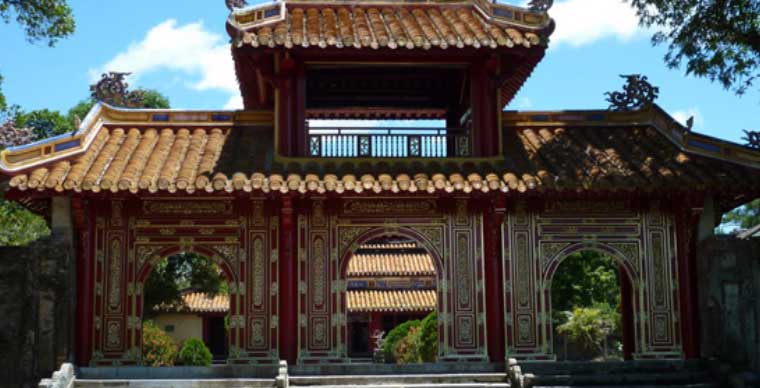
2. Stately Minh Mang Royal Tomb
Emperor Minh Mang (1820-1840)
Located on Cam Khe Mountain, Huong Tho Commune, Huong Tra District, near Bang Lang Tomb, Minh Mang Tomb (or Hieu Lang) is the resting in peace place of the second king of Nguyen Dynasty.

Minh Mang tomb had been built from 1840 to 1843, 26 hectares large, is a comprehensive integrative design that includes 40 constructions of different sizes. In front of the tomb, there are 3 doors, the middle is Dai Hong Mon (only opened once when the procession of King Minh Mang entered the tomb), the two sides are Ta Hong Mon and Huu Hong Mon. Inside the Dai Hong Mon is a courtyard, on two sides, there are two stone statues carved with figures of martial and literature generals also elephants, horses standing as imperial audiences.

King Minh Mang was a great contributor to the country's expansion work, bringing Dai Nam (Vietnam at that time) to the strongest position in Southeast Asian nations at that time. During his stay, the king had many important national reforms.
Visiting Minh Mang tomb, visitors have the feeling like they’re lost in a space of art, literature, and philosophy. The majestic vibe and the stillness of the architecture in the tomb is the evidence for the king’s erudite knowledge and romantic soul.
>>>12 km away from the center of Hue city.
3. Poetic Tu Duc Tomb
Emperor Tu Duc was the second son of Emperor Thieu Tri, in position for 36 years, the longest reign period in the history of Vietnam.
He did not have children, he took three nephews as his sons: Nguyen Phuc Ung Chan (later became Emperor Duc Duc); Nguyen Phuc Ung Duong (later became Emperor Dong Khanh); Nguyen Phuc Ung Dang (later became Emperor Kien Phuc).

Located in a narrow valley in Thuong Ba village, Thuy Xuan commune, Hue city, Tu Duc tomb (or Khiem Lang) was built from 1864 to 1867 on an area of 475 hectares. In addition to the purpose of burial at death, this is also the place where the king comes to rest, read, recite poetry ... so the landscape of the tomb is like in a large park. Especially on the left side of Luong Khiem street, there is Minh Khiem theater which is considered as one of Vietnam's oldest theaters, where the king enjoyed music and other forms of art.
>>>7 km from Hue.

4. Delicate Khai Dinh Tomb
Being the resting place of King Khai Dinh, the 12th emperor of the Nguyen Dynasty, Khai Dinh Tomb (or Ung Lang) locates on Chau Chue Mountain, Thuy Bang Commune, Huong Thuy District. This is the only tomb with the mixture of both East and West architecture.
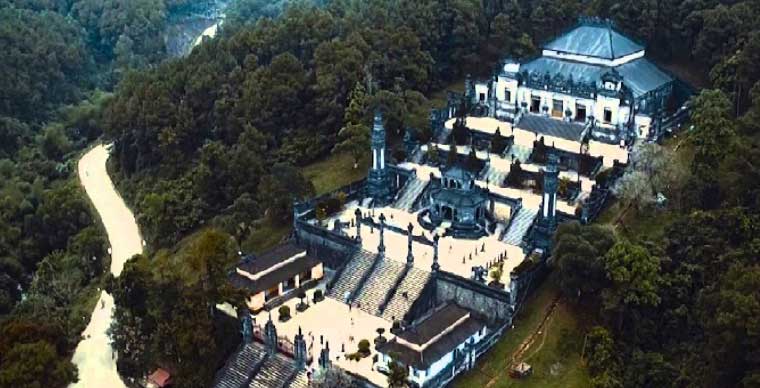
Unlike the traditional architecture of the Nguyen Dynasty, the mixture of many schools of architecture such as Hinduism, Buddhism, Roman, Gothique ... has left their marks on the works of the tomb.
The entire interior of the palace is decorated with porcelain and glass tiles. From the set of paintings, bowls, flowers, cups, tea tray, crown ... to the very modern items such as alarm clock, tennis racket, oil lamp … are also used to decorate here.
Despite the humble size, Khai Dinh tomb has a very meticulous design so it took much more time and money to build up. The tomb was built in 10 years, from 1920 to 1930.
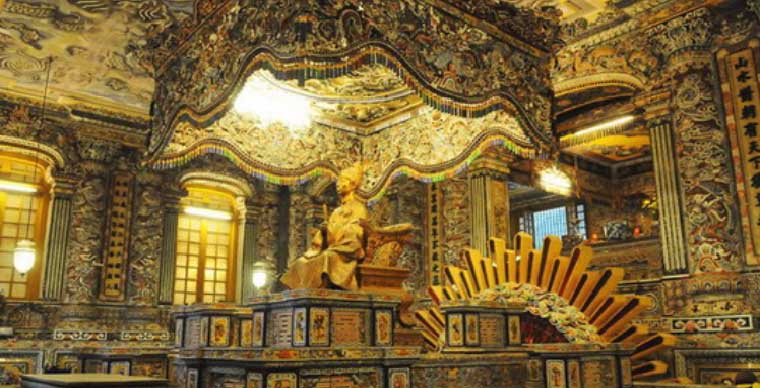
Especially, Khai Dinh tomb is famous for three mural paintings "Cuu long an van" ( 9 dragons hiding in the cloud) decorated on the ceiling of three pavilions in Thien Dinh Palace, considered as the most magnificent and valuable mural paintings in Vietnam.
>>> About 10km Southwest of Hue City
Related articles:
>> Vietnam tour 2023-2024: Where to go? Which itinerary? What to do? How many days?
>> Iconic French architecture buildings in Hue, Vietnam - the Hidden land
>> Hue Imperial city - A to Z Travel guide
>> 7 famous foods in Hue
Comment
Other Blog
Categories
Latest News
on 31 Dec, 2025
on 31 Dec, 2025
 Español
Español Français
Français






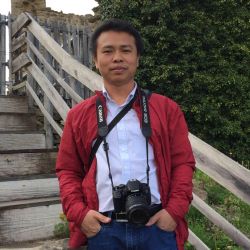
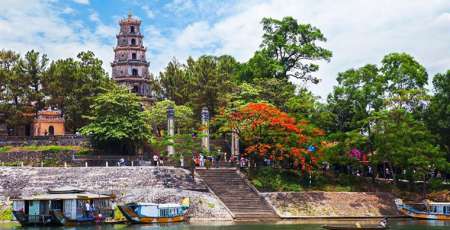



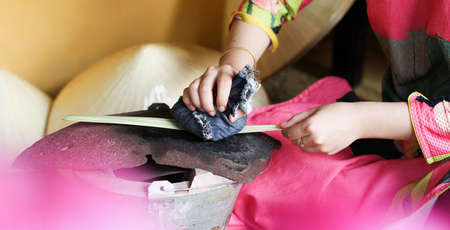








Morgane Ter Cock
on Dec 18, 2025HerbertPhomaMS
on Oct 19, 2025Lilyan Cuttler
on Oct 15, 2025Avenue17XC
on Sep 14, 2025Avenue18JL
on Jul 21, 2025